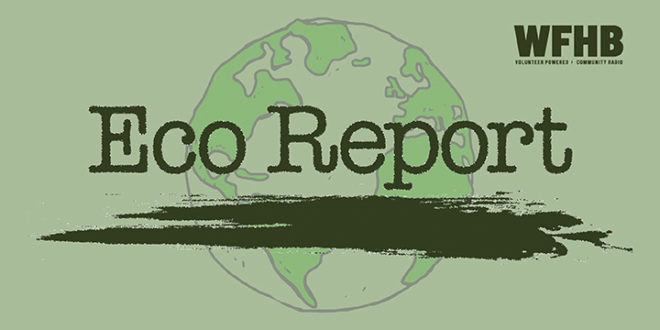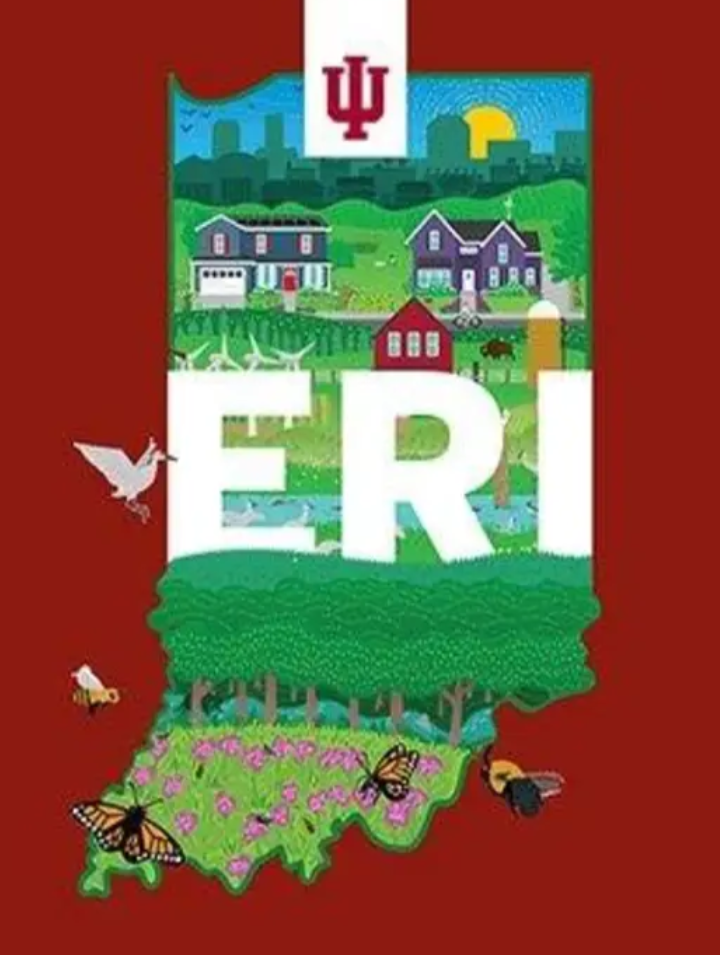Podcast: Play in new window | Download (Duration: 29:22 — 40.4MB)
Subscribe: RSS
Hello and welcome to Eco-Report. For W-F-H-B, I’m Julianna Dailey. And I’m Cynthia Roberts. Later in the program, we conclude with Part Four of a series by Environmental Correspondent Zyro Roze from an interview with Bill Brown of the Environmental Resilience Institute or E-R-I of Indiana University on how E-R-I assists institutions, communities, organizations, businesses and governmental entities to plan for, mitigate and adapt to Climate Change impacts.
| And now for your environmental reports:
According to NUVO, a news organization based in Indy, Indiana lawmakers passed more than three dozen bills in the just-concluded session. Most of the bills are intended to make operating in Indiana more profitable for electric and water utilities or their fuel suppliers. By the Indiana Environmental Reporter’s count, Indiana lawmakers passed 15 bills affecting utilities, including some that allow them to pass more of their costs directly to consumers, prolong the life of fossil fuels and place more hurdles in the way of large-scale renewable energy system adoption. Indiana lawmakers also passed eight bills affecting various parts of state water issues in the state. Some of the bills target water infrastructure funding and make it easier for schools and childcare facilities to test for contaminants. Other bills focus on changing how the state regulates new types of septic tanks, water districts, and other issues. This year, lawmakers also focused on establishing and funding economic development initiatives that would help develop brownfields and reclaim coal mines. However, they would tax drivers who use fossil fuel alternatives and punish financial institutions that choose to limit their investment in fossil fuels. Bills regulating new technology in the state, like small modular nuclear reactors, carbon capture and sequestration, and advanced recycling, have also passed, as well as bills that authorized land use studies and PFAS blood monitoring for firefighters. In regard to UTILITY BILLS:The Indiana General Assembly passed bills that establish a five-pillar guideline for making energy policy decisions;
Lawmakers also passed a bill that would allow the Environmental Rules Board to update air permit fees, establish guidelines for communities to accept solar and wind energy systems and study the best practices for the disposal of solar panels and wind turbine blades. Other bills passed would authorize pay raises for water district board members, require state homeland security authorization for expanding battery energy storage systems, set the foundation for further taxing of utilities with wind energy systems and authorize a state program to pay for half of the costs of decommissioning or replacing underground petroleum tanks. —Norm Holy |
Continuing with the Indiana Legislative Environmental bills, there are also WATER POLICY BILLS:Indiana lawmakers passed two bills authored by the same legislator that deal with flood plains in different ways. Senate Bill 242 repeals the requirement for local floodplain administrators to use the best available floodplain mapping data when reviewing permit applications to build in or near a floodplain, while Senate Bill 412, among other flooding issues, prohibits the same administrators from issuing building permits if those permits threaten eligibility in the National Flood Insurance Program. The Indiana General Assembly also passed bills expanding the use of above-ground onsite residential sewage discharging disposal systems in place of repairing old septic tanks, changing the requirement for water system mercury permit changes when they are proven not to contribute to Ohio River mercury problems and requiring water systems not subject to the Indiana Utility Regulatory Commission to require commission approval before building new wastewater treatment plants. Other bills make it easier for communities to receive infrastructure loans and grants from the Indiana Finance Authority, require lead testing and mitigation at preschools and childcare facilities and ease the process for counties to join a watershed development commission. Then there are the Omissions: In addition to specific areas described above, there are a few other things that should be cited. The legislature still does not allow discussion of “climate change.” The rebuff of the climate initiative by 20,000 high school students represents incredible arrogance. The state has not chosen to improve its 48th rank in water and air quality. There was no plan to improve life expectancy in counties downwind of points of pollution such as coal-fired power plants. Finally, resolving that natural gas is not a fossil fuel is laughable. —Norm Holy |
| This week we’ll report more statistics regarding life expectancy. Earlier we reported on life expectancy in each county in 2018. The differences were large. In wealthy white areas with no coal-fired power plants around, life expectancy was nearly 80 years. In areas downwind of power plants and other sources of air pollution, life expectancy was as low as 72+ years.
In this report the objective is to gain some idea of the effect of covid on life expectancy. The latest figures are available for 2021 from the National Statistics Report. The covid effect is, thus, not fully captured. It was anticipated that since many Hoosiers, especially in the southern part of the state, did not comply with the mask advisory, lower expectancies were anticipated. The Indiana life expectancy (male and female) was 76.8 years in 2018 (pre-covid) and 75.0 years in 2021. Covid is not the only cause of the drop, but seems likely to be the major contributor. Ranking states by life expectancy reveals that Indiana ranked 40th in 2018 and 41st in 2021. Thus, our handling of the disease was typical with other states. Indiana is toward the bottom of states because we have a high percentage of smokers, obesity is an issue, and we have very high air and water pollution. The top 10 states with the longest life expectancy are all “blue” states. The bottom ten, including Indiana, are all “red” states. —Norm Holy |
| The snowbirds among us depart for Florida in the winter to enjoy the warm weather and beach. One of the fixtures in terms of bird life is the anhinga, a water bird with a snakelike neck. Recently an anhinga has turned up in an unexpected place: Brooklyn. This is a sign of shifting ranges for birds from the South.
(quote) What we are seeing here is likely an expanding population from the previous typical range of the species in the southeastern United States, (end quote) said Andrew Farnsworth, a researcher at the Cornell lab. He added that the anhinga is a strong flier and quite a migrant, so it’s not necessarily a surprise this is happening. So if you see a bird swimming with just its head and neck out of the water, it could be an anhinga living near you. —Norm Holy |
| In 2019, research revealed that the US and Canada had lost nearly a third of their birds – 2.9 billion all together, since 1970. As bleak as this picture may be, it’s not too late to make a difference for our local bird populations. You can plant trees, and take other easy steps, to help them thrive.
Birds contribute to our food supply by pollinating 5% of all plants grown for human consumption. They also quietly go about keeping insect populations in check! A Baltimore Oriole can consume 17 hairy caterpillars in a minute. A house wren feeds 500 insects to its young every summer afternoon and a pair of flickers consider 5,000 ants a mere snack. You can help the bird population by planting trees with fruit, nuts, or seeds that attract birds. Plant trees that are different heights at maturity. Set out a bird bath and keep it filled with clean water. Hang a bird feeder and if possible, retain dead trees – the woodpeckers love them. These are just some ways to support our feathered friends. —Julianna Dailey |

And now…we present the final segment of Zyro Roze’s interview with Bill Brown, Assistant Director for Strategy and Engagement at Indiana University’s Environmental Resilience Institute as they explore how the Campus works with the City and other institutions to secure funding, data and expertise while also touching on how eco design strategies can make housing more affordable by assessing the true costs and benefits of going beyond conventional approaches to residential infrastructure.
|
| For Eco Report, I’m Julianna Dailey. And I’m Cynthia Roberts |
| Are you looking for a way to make a difference on environmental issues? Here at EcoReport we are currently looking for reporters, engineers, and segment producers. Our goal is to report facts on how we’re all affected by global climate disruption and the ongoing assaults on our air, land and water. We also celebrate ecologists, tree huggers, soil builders and an assortment of champions who actively protect and restore our natural world, particularly those who are active in south central Indiana. All levels of experience and all ages are welcome, and we provide the training you’ll need. W-F-H-B also offers internships. To volunteer for Eco-Report, give us a call at (812) 323-1200, or e-mail us at: Earth at W-F-H-B dot O-R-G. |
| And now for some upcoming events:
Join Indiana native plant expert, David Mow at Brown County State Park on Saturday, May 27th, from 1 to 2 pm for a highly informative session on edible plants. Learn how to identify plants, what their uses are, and rules for collecting in Indiana State Parks. |
| Drop by the Paynetown State Recreation Area at Monroe Lake to learn about Clever Crows on Sunday, May 28th, from 2 to 3:30 pm. Meet at the Activity Center Patio to learn how smart crows are and then take some time to make a crow puppet. |
| A Creek Stomp at Spring Mill State Park is scheduled for Sunday, May 28th, from 3 to 3:30 pm. Wade in the cold creek to search for fresh water creatures. Learn how they help determine the quality of the water. |
| Tag along on a Herp Hike through Griffy Lake Nature Preserve on Friday, June 2nd, from 6 to 8 pm to look for amphibians and reptiles. Learn all about frogs, snakes, lizards and salamanders; how to find them and their role in the ecosystem. Register at Bloomington.IN.gov/parks. |
| Pastors for Peace is sponsoring a trip to Cuba from June 26th through July 6th, to learn practices focused on fighting the climate crises. The trip doesn’t take place until the end of June, but you need to register now at [email protected]. |
| And that wraps up our show for this week.
EcoReport is brought to you in part by M-P-I Solar, a Bloomington business specializing in solar hot water, solar electricity and solar hot air systems. M-P-I Solar designs and installs solar power generation systems that encourage independence and individual responsibility. Found locally at 812-334-4003 and on the Web at M-P-I solar energy dot com. |
| This week’s headlines were written by Norm Holy and Julianna Dailey. Today’s news feature was produced by Zyro Roze and edited by Noelle Herhusky-Schneider. |
| Julianna Dailey assembled the script which was edited by Zyro Roze. Julianna Dailey compiled our events calendar. Kade Young and Noelle Herhusky-Schneider produced and Branden Blewett engineered today’s show. For W-F-H-B, I’m Julianna Dailey and have a safe and happy Memorial Day. And I am Cynthia Roberts. And this is EcoReport. |
 WFHB Bloomington Community Radio
WFHB Bloomington Community Radio



